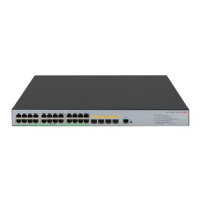383
Value Meanin
Remarks
3 Subnet-local scope IPv6 admin-scope zone
4 Admin-local scope IPv6 admin-scope zone
5 Site-local scope IPv6 admin-scope zone
6, 7, 9 through D Unassigned IPv6 admin-scope zone
8 Organization-local scope IPv6 admin-scope zone
E Global scope IPv6 global-scope zone
IPv6 PIM-SSM overview
The source-specific multicast (SSM) model and the any-source multicast (ASM) model are opposites. The
ASM model includes the IPv6 PIM-DM and IPv6 PIM-SM modes. You can implement the SSM model by
leveraging part of the IPv6 PIM-SM technique. It is also called "IPv6 PIM-SSM."
The SSM model provides a solution for source-specific multicast. It maintains the relationships between
hosts and routers through MLDv2.
In actual application, MLDv2 and part of IPv6 PIM-SM technique is adopted to implement the SSM model.
In the SSM model, receivers know exactly where an IPv6 multicast source is located by using
advertisements, consultancy, and so on. This model does not require RP or RPT, and it does not require
a source registration process for the purpose of discovering IPv6 multicast sources in other IPv6 PIM
domains.
In IPv6 PIM-SSM, the term "channel " refers to an IPv6 multicast group, and the term "channel
subscription" refers to a join message.
The working mechanism of IPv6 PIM-SSM is summarized as follows:
• Neighbor discovery
• DR election
• SPT building
Neighbor discovery
IPv6 PIM-SSM uses the same neighbor discovery mechanism as in IPv6 PIM-SM. For more information,
see "Neighbor discovery."
DR election
IPv6 PIM-SSM uses the same DR election mechanism as in IPv6 PIM-SM. For more information, see "DR
election."
SPT building
The decision to build an RPT for IPv6 PIM-SM or an SPT for IPv6 PIM-SSM depends on whether the IPv6
multicast group that the receiver will join falls into the IPv6 SSM group range. The IPv6 SSM group range
that IANA has reserved is FF3x::/32, where x represents any legal address scope.

